
Reserved Area
Artists - ArtWorks
Papa Vitan the Elder and Papa Vitan Junior
 Bulgaria
BulgariaTryavna art school ? Bulgarian renaissance
The icon-painters /zografs/ from the Vitan family.
Papa Vitan the Elder – icon of Christ /1798, presented in the Architectural museum - Sofia/, icon of Mother Mary and St. Nicholas /church museum – Sofia/;
Papa Vitan Junior – an icon of Mother Mary and an icon of Archangel Michael – presented in the church “St. Archangel Michael” in the city of Tryavna.
Tryavna art school – Bulgarian renaissance. The largest religious art school, which functioned for 2 centuries – from the end of the 17th until the end of the 19th century. This is the time of the ottoman reign during which crafts bloom in the small Balkan mountain cities. This is the beginning of the Bulgarian revival.
There are tens of icon painters from the Tryavna school and they have created classical post-Byzantine and revival masterpieces.
Historically – taking advantage of the privileges given by the Ottoman rulers (being exempt from some taxes and Turks being forbidden to settle down in the city of Tryavna) and also considering the land is scarce and unyielding, the people of Tryavna diligently set to develop different kinds of crafts and this soon lead to the fast development of the city and enriched its citizens.
This is why the city was called Altun Tryavna, which means golden Tryavna. This name remained for many years.
Artistically – its peak in the development of arts and crafts Tryavna reached during the revival period, which left a rich cultural heritage. During this period of nation wide awakening and bloom, the city turned into a center of quickly developing construction, engraving, icon-painting – famous talented artists, craftsmen, builders created remarkable pieces of art and culture. The main factors for the blooming of these arts and crafts in Tryavna are several: the abundance of wood material and stone, the scenic landscape and the nature of the mountain, the proximity of the ex-capital of the country and the traditions of Trunovo art school, and, which is most important, the rich unique souls of the local people. According to the specialists the art of the Tryavna masters is so abundant and unique that the presence of a complete Tryavna art school is indisputable. This art school is the largest of all revival ones and has the biggest territory. Art works created by Tryavna masters can at present be found in more than 500 cities and villages throughout Bulgaria!
Characteristic of this art school is that the artists created predominantly icons and very rarely murals.
The schools, bridges, churches, clock-towers, murals and icons, iconostases and wood-engravings created by the Tryavna masters spread their fame for about two centuries not just in Bulgaria, but also in Serbia, Walachia, Turkey, Persia, Austria and Russia.
The names of 70 famous icon-painters from six large painter-families – Vitanovski, Minchevski, Zahariev, Pop Dimitur Kunchevski and Venkovski – are well known today.
The most prominent of them are Vitan Tsonkov the Elder (born 1760), whose icons of Christ /1798/ and Mother of God /1807/ are preserved as valuable relics in the National archeological museum in Sofia; Simeon Tsonyuv Vitanov (born around 1768), one of the best representatives of the Tryavna art school, whose icon “St. Nikola” is preserved in the same museum; Vitan Koyuv Junior (born about 1791) is recognized as the most talented face-painter of the Vitan family; Tsanyo Zahariev Junior (1840-1902) is a prominent member of the Zahariev family and in his icons we find images of the real world; Simeon Tsonev-Monata (1851-1881) was a very good artist with many broad interests – he was the first one to bring a photo camera to Tryavna.
Our culture will always cherish the works of the famous Tryavna masters who have perfectly reflected in their art the new spirit of the epoch and the big Revival ideas.
The most prominent carvers from the Tryavna wood-carving art school are:
- Dimitur Oshanetsa (born around 1780), who supported by his journeyman Ivan Bochukovetsa built in 1804 the house of the tradesman Hristo Daskalov. This house is transformed in a museum of carving and painting arts.
- Vitan Koyuv Mladi was not only a painter but also a famous carver, whose iconostasis in the church “St. Archangel Michail” is a unique piece of carving art;
- pop Koyu Vitanov (1821-1891) carved the bishop’s throne in the same church – a unique monument of carving art;
- Gencho P. Marangozov (1881-1956) is one of the most gifted local carvers – his masterpiece is the iconostasis in the church “St. Kiril and Methodius” in Sofia, as well as many busts, bas-relieves, friezes, which today fill in the exposition at the Tryavna museum.
Famous are also the Tryavna master-builders, who were the first to create the image of the XIX century Bulgarian Revival house.
The Tryavna art school started up and developed as a part of the crafts, which blossomed here – construction, wood carving, painting. The skills are passed in the families – from father to son – and have been preserved for ages.
The Tryavna art school in comparison to the Samokov art school works mainly with icons and in close connection with wood carving (iconostases orders). Murals are a rarely created by Tryavna artists and they are not considered characteristic for this regional art school.
The Tryavna art school is characterized as unique, with multitude of different artists’ styles /images, colors, compositions/, which make it easy to distinct from the Bansko and Samokov art schools.
The early representatives of the family /papa Vitan the Elder/ used ancient style approaches in their art. Gradually their heirs changed their views and linger away from the family icon-painting traditions.
The works of the Vitan masters are distinguished by their professionalism, sense of colors and harmony, human facial expressions and bright interest towards the world around, which is presented as a background in their icons, as well as open to the innovations, which reach Bulgaria through Athos, the adjacent countries, Russia and western Europe.
The zografs from the Samokov and Bansko art schools were trained in the monasteries of Athos, while the Tryavna masters are similar to the naivists, they took and processed with great fantasy elements from the western European, Russian and Balkan fine arts, still preserving their personal touch. The Tryavna masters were very popular and sought – they worked throughout the entire Bulgarian territory, including the territories of the masters from Samokov and Bansko art schools. True icon painting drops off with the advance of humanism in European art. Due to its unaware backwardness in recreancy, Bulgaria becomes the last “fortress” of real icon-painting in the first half of the ХIХ century. The last true masters of sacral fine arts are Dimitur Tomov Ikonomov from Bansko, Dimitur Hristov from Samokov and Joanikij papa Vitanov from Tryavna. All three of them have been born in the end of the ХVIII century.
The Vitanov’s family from Tryavna is among the oldest and most famous Bulgarian families of zografs /painters/ and carvers. According to family annals the first master was Vitan Karchov, who studied in the monasteries of Athos and worked during the first half of the XVII century. None of his works are documented though. He trains his offspring and thus the craftsmanship passes from father to son. Two generations later, at the end of the XVIII century, the brothers Vitan the Elder, Koyu and Simeon Tsonyuvi and Georgi Dimitrov present their art. They train their sons Yoakin papa Vitanov, Dosyu and Simeon Koyuvi, who on their part pass the skills to their heirs. Some of them are remarkable wodd-carvers.
The style of these authors distinguishes them from the art of the other schools – Deburska, Samokovska, Banska and so on.
Encyclopedia of visual arts in Bulgaria, volume І, А – L. Sofia, Bulgarian academy of sciences, 1980, pages 151 - 152.
Encyclopedia of visual arts in Bulgaria, volume. ІІІ, S – Z. Sofia, Bulgarian academy of sciences, issue of “Marin Drinov” publishing house, 2006, page 28.
A. Vasilev, Bulgarian renaissance masters, 1965.
A. Bojkov, Tryavna art school, 1967.
http://www.pravoslavieto.com/art/shkoli/trevnenska/index.htm
http://www.pravoslavieto.com/art/shkoli/trevnenska/1790-1853_joanikij_papa_vitanov.htm
http://www.answers.com/topic/tryavna-school-2?cat=entertainment
http://www.travel-bulgaria.org/Culture_and_History_Architectural_monuments_Tryavna.html
http://bgtravel.design.bg/etis/article.php?aID=217
Related Material:
Image available
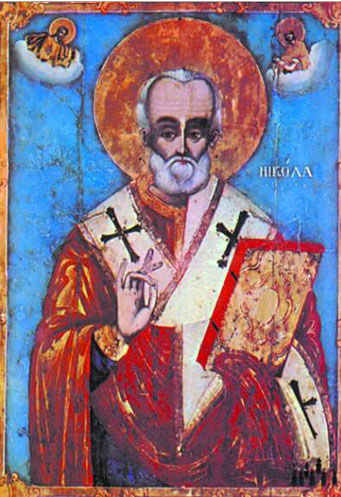
File name: 20_bg - xvii -Nicolas.jpg
Description of the material:
St. Nicolas the Wonderworker. Icon from 1831 by Joanikij papa Vitanov. Preserved in the church “St. Nicolas the Wonderworker“ in Sliven.
Contextualisation Of the source:
The image was withdrawn from an online gallery presenting art works by Tryavna masters. http://www.pravoslavieto.com/art/shkoli/trevnenska/index.htm
Interpretation of the source:
This is another demonstration of how the heirs of the Vitan family gradually changed their views and lingered away from the family icon-painting traditions. The colors are brighter and richer, the harmony and posture freedom are visible. The expression of the saint is human and the attire and background are presented with great detail and copiousness.
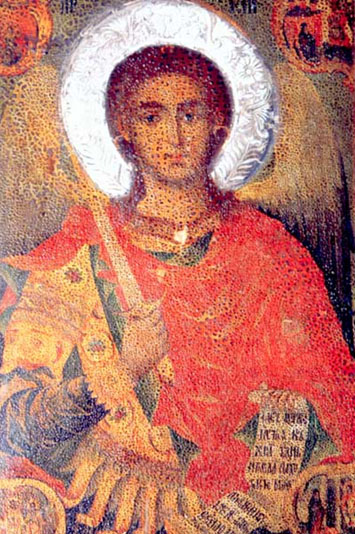
File name: 20_bg - xviii - Archangel Michael.jpg
Description of the material:
A mural icon “St. Archangel Michael”. A detail from an 1820 mural by Joanikij papa Vitanov (1790-1853). Preserved at church “St. Archangel Michael “in Tryavna.
Contextualisation Of the source:
The image was withdrawn from an online gallery presenting art works by Tryavna masters. http://www.pravoslavieto.com/art/shkoli/trevnenska/index.htm
Interpretation of the source:
This icon is a demonstration of how the heirs of the Vitan family gradually changed their views and lingered away from the family icon-painting traditions. The colors are brighter and richer, the harmony and posture freedom are visible. The saint has a human facial expression and his attire and weaponry is presented with great detail and copiousness.
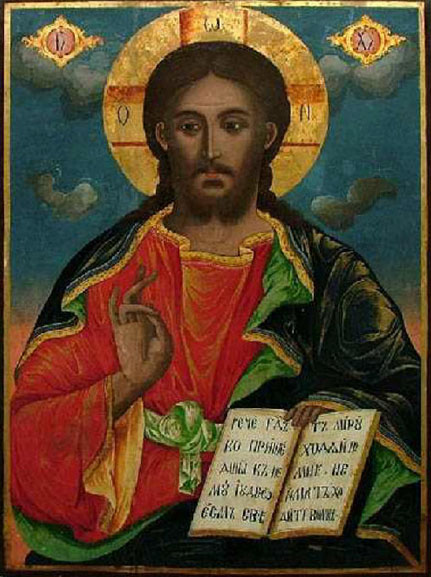
File name: 20_bg - xviii - Christ Pantokrator-Junior.jpg
Description of the material:
An icon “Christ Pantokrator” by papa Jonaikij Vitan Junior. The year of the icon is 1836 – XIX century – but the idea of presenting it here is for the learner to spot the differences between what artistic approaches were used by the Elder and the Junior when presenting one and the same typology.
Contextualisation Of the source:
The material was withdrawn from a dedicated online gallery with works by this artist.
Interpretation of the source:
This icon is a demonstration of how the heirs of the Vitan family gradually their heirs changed their views and lingered away from the family icon-painting traditions. The change in the sense of colors and harmony as well as the human facial expression of Christ in the icon is visible.
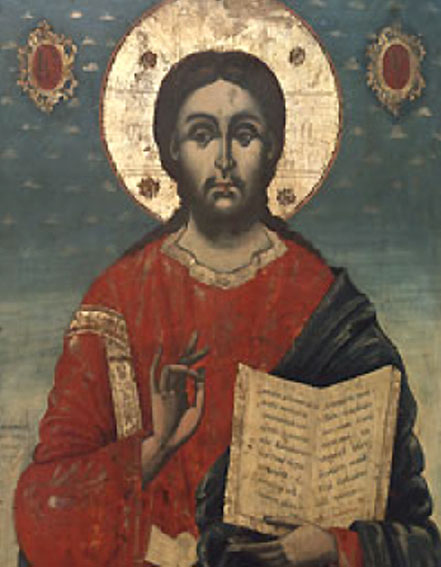
File name: 20_bg - xviii - Christ Pantokrator.jpg
Description of the material:
An icon “Christ Pantokrator” created by papa Vitan the Elder from Tryavna. 1798
Contextualisation Of the source:
The icon is at present preserved in the crypt of the patriarchal cathedral “St. Alexander Nevski”, a branch of National art gallery in Sofia. The image was withdrawn from an online gallery with Christ icons - http://www.pravoslavieto.com/ikonopis/Gospodski/pantokrator/index.htm
Interpretation of the source:
This icon demonstrates the use of ancient style approaches in the art of papa Vitan the elder, who was trained at the monasteries of Athos. The next image shows the same icon-topic but created by papa Joanikij Vtan Junior. It is presented here, despite its later year, for comparison purposes.
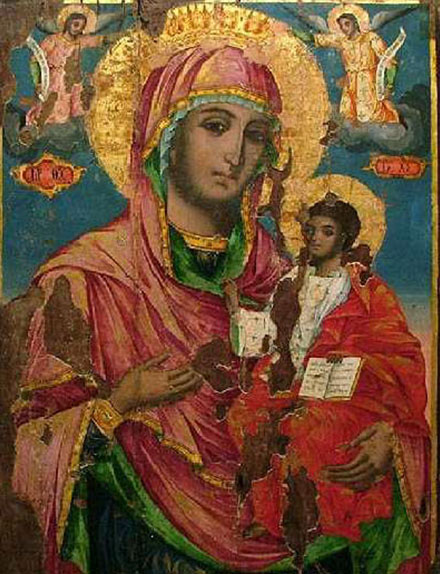
File name: 20_bg - xviii - Mother of God.jpg
Description of the material:
Mother of God with baby Christ. An icon by Joanikij papa Vitanov - 1836. Temporary exposition “Christian art” in Sliven.
Contextualisation Of the source:
The image was withdrawn from an online gallery presenting art works by Tryavna masters. http://www.pravoslavieto.com/art/shkoli/trevnenska/index.htm
Interpretation of the source:
This is another demonstration of how the heirs of the Vitan family gradually changed their views and lingered away from the family icon-painting traditions. The colors are brighter and richer, the harmony and postures freedom are visible. The expressions, especially the one of the Mother of God is human and the attire and background are presented with great detail and copiousness.
Comments about this Artist/ArtWork
Michelangelo - Copyright 2008 - This project has been funded with support from the European Commission